Last Updated on January 9, 2025 by Team Ideas24
Now here’s something to keep the little kids busy this weekend. It’s simple, easy, addictive, and definitely worth displaying on the wall!
This line design project is just one of the many creative ideas taught yearly by art teacher Ted Edinger (also known as Mr. E). Lots of his students have created really impressive versions of this, and several other parents and teachers have borrowed his idea to teach to kids as well. :)
It’s a fun activity that will surely be a hit and also beneficial as it develops the artistic side!
Want to create your own version of this together with the little ones? Then get your quick art lesson now with Mr. E’s tutorial below!
Contents [show]
Creating Line Design Project Art
Materials
- 9 x 12 Paper – consider the coloring medium that you are going to choose
- Sharpie Marker
- Colouring Medium – Watercolor Pencil, Watercolor, Crayons, Colored Pencil, or Marker (see bottom of the post for more notes on this)
Instructions
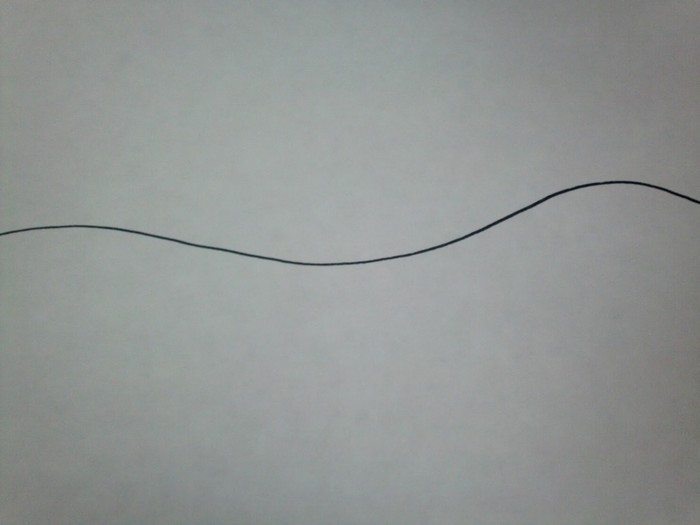
Start with a gentle curve line across the paper. Don’t go too crazy hilly with the line…it will make it difficult in the steps that are to come!
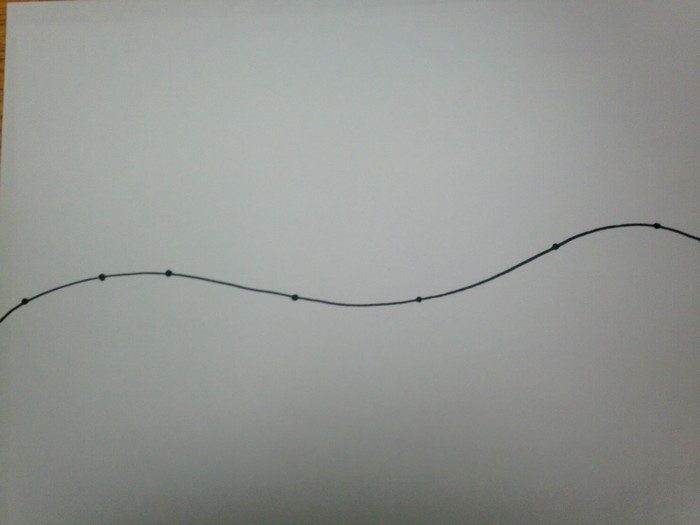
Place eight dots on the line spaced at different distances.

Go dot – to – dot across the entire line. Do not continue to do this however…or it will create a kind of boring column like work(going straight up & down).
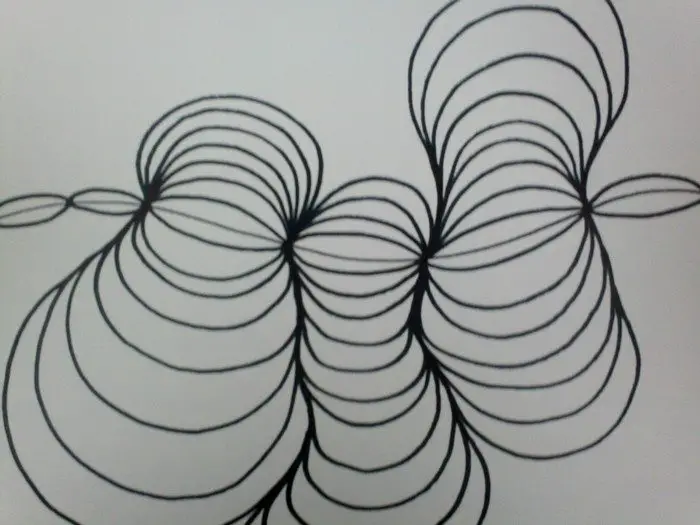
As you are going dot -to- dot, you need to “camp out” on some of the segments. This will help them to balloon out & look oh so cool! This will also cause others to be “pinched off”…and that is fine. The lines need to continue off of the paper…and should not just stop cause they are close to the edge. As it gets bigger and bigger, the lines will have to be shared going back to the dot…and yes..they should really go back to the dot. Going back to the dot each time creates the darker shadow”ish” areas that help create depth.
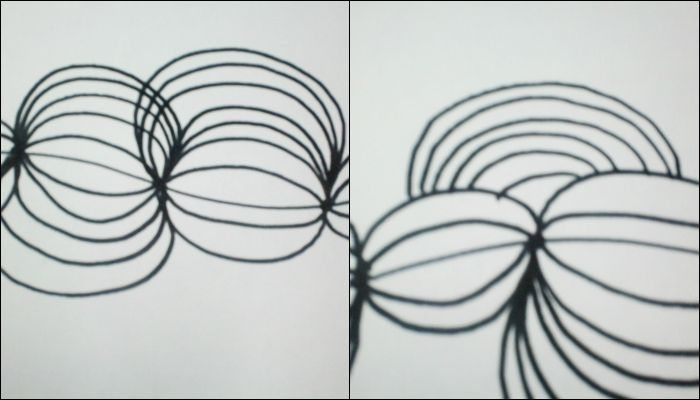
The two pictures above are the WRONG way to do this. The lines should NEVER crisscross each other. I tell my students that the lines can share a path…but never cross over another line. The second picture is the “RAINBOW CONNECTION”. It is a lot easier to do it that way..but it is not correct.

So here you see the results of the ballooning out, pinching off, and going off the edge of your paper.

- Watercolor Pencil – A little labor intensive, after you color it..you have to go over with with a brush.
- Watercolor – I like this a lot, but you would need to make sure the students understood to not put color beside color because of bleeding.
- Crayons – This works much like colored pencils, but they are a bit chunkier so it’s hard to get into the small spaces.
- Colored Pencil – This is how I usually do the project with my students…I love colored pencils!
- Marker – This kind of takes the shading element out of the project, but if you were going more for color families and such… could work!
Here are more work samples from the kids in Mr. E’s classes…
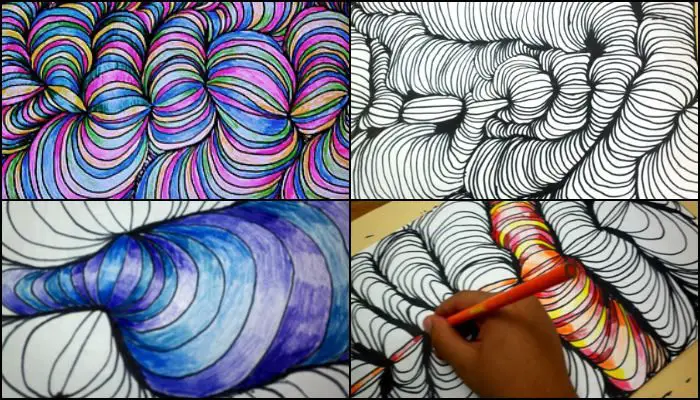
Is this going to be your weekend activity with the kids? :)
Thanks to Ted Edinger for this wonderful project! Take a look at his amazing site. It’s full of fun and creative art project ideas for kids!
Advanced Shading Techniques in Line Design Project
Line design is a fundamental element of art that transcends the simplicity of drawing to embody the essence of visual storytelling. It’s about creating outlines and using lines to convey depth, texture, and emotion. When paired with advanced shading techniques, line design can transform a flat image into a lifelike piece that captivates the viewer’s imagination. Let’s delve into some advanced shading techniques that can elevate your line design projects to new heights.
Cross-Hatching
Cross-hatching is a classic technique in line design project that involves drawing sets of parallel lines over each other at different angles. This method allows for the creation of texture and depth, making it possible to achieve various tones and shadows in your design. The closer the lines are to each other, the darker the area appears, enabling you to create a gradient effect purely with lines. Cross-hatching is particularly effective in pen and ink drawings, offering a dynamic way to convey form and volume.
Stippling
Stippling involves placing small dots at varying densities to simulate shades and tones inline design. The technique is time-consuming but offers unparalleled control over the lightness or darkness of an area without traditional shading. Stippling can create a unique texture that is hard to achieve with other methods. It’s especially suitable for designs where a soft, ethereal quality is desired or to add a tactile dimension to your line work.
Scribbling
Scribbling might sound unstructured, but it becomes a powerful shading technique in a line design project when applied with intent. You can create dynamic textures and depth by varying the pressure, density, and direction of your scribbles. This approach lends a raw, energetic quality to the artwork, making it stand out. Scribbling is not just for rough sketches; it can be refined to suit more sophisticated line designs, adding an organic, lively touch to your work.
Contour Shading
Contour shading builds on the concept of line design by using lines that follow the shape and contour of the subject. This technique enhances the three-dimensional illusion, making the subject appear more lifelike. Contour shading can be subtle, with lines closely mirroring the form or more pronounced for a dramatic effect. It’s particularly effective in emphasizing the curvature and volume of objects in your line design projects.
Blending
While blending is often associated with broader swaths of color or graphite, it can also be adapted to line design by carefully integrating line work with blended backgrounds or elements. This technique softens the contrast between the lines and the shading, creating a smooth transition between light and dark areas. Blending can add sophistication and realism to line designs, especially when combining mediums like ink and pencil.
By incorporating these advanced shading techniques into your line design projects, you can push the boundaries of what’s possible with simple lines. Each method offers a unique way to add dimension, texture, and emotion to your artwork, transforming basic line drawings into complex, evocative pieces.
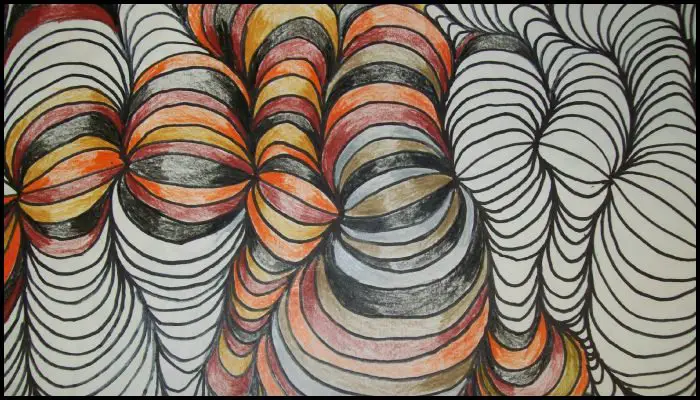
Incorporating Line Design in Different Mediums
Line design is a versatile art form that is the backbone of visual expression across various mediums. It’s the thread that weaves through the fabric of artistic disciplines, offering a universal language of creativity. By exploring line design beyond traditional pen and paper, artists can discover new dimensions of expression and innovation.
Let’s explore how line design can be seamlessly incorporated into different mediums, enriching the artistic process and outcome.
Digital Art
In digital art, line design takes on a new level of precision and versatility. Digital tools and software offer an array of line styles, weights, and textures that can be easily manipulated. Artists can experiment with layers, undo options, and infinite colors to refine their line work. Incorporating line design in digital creations enhances detail and depth and allows for experimentation that is not possible with traditional materials. Line design is fundamental in creating compelling digital artwork, from intricate vector illustrations to dynamic digital sketches.
Textile Design
Line design in textile design transforms ordinary fabrics into canvases of intricate patterns and stories. Through embroidery, screen printing, and weaving techniques, lines can create texture, form, and color dynamics within the fabric. In embroidery, for instance, the variety of stitches available can mimic the effects of drawing lines, offering a tactile dimension to the design. Screen printing utilizes line art stencils to apply unique patterns onto fabric, showcasing how line design can bridge art and fashion.
Sculpture
Sculpture may seem like a medium far removed from line design, yet lines play a crucial role in defining shapes, contours, and textures within three-dimensional spaces. Wire sculptures directly translate line design into 3D form, where the line becomes the structure. In more solid materials, the line concept is represented through edges, ridges, and the interplay of light and shadow, proving that line design is as much about perception as physical drawing.
Ceramic Art
In ceramic art, line design is crucial in adding decorative elements to pottery and sculptures. Techniques such as sgraffito, where lines are scratched into the surface to reveal layers beneath, or slip-trailing, where lines are applied to the surface for texture and pattern, showcase the adaptability of line design ideas in this medium. These methods allow artists to draw directly onto their creations, blending the boundaries between two-dimensional design and three-dimensional form.
Graphic Design
Line in design is a cornerstone of graphic design, where it’s used to create logos, icons, and layouts that communicate and engage. Lines direct the eye, emphasize information, and establish hierarchies within designs. They can be used to draw attention, create borders, and separate content, proving their versatility. In branding, a well-crafted line design can become a timeless symbol that embodies the essence of a brand.
Mixed Media Art
Mixed media art thrives on integrating various artistic elements, and line design often holds these pieces together. Artists can create complex, layered compositions by combining line work with photography, collage, or painting. Line design provides structure and cohesion, guiding the viewer’s eye across the artwork and tying together diverse elements into a unified whole.
Incorporating line in design across different mediums opens up a world of creative possibilities. It underscores the adaptability and universality of line work in the arts, demonstrating that line design is an essential tool in the artist’s repertoire regardless of the material or technique. By exploring line design in these diverse mediums, artists can push the boundaries of their creative expression, finding new ways to convey their vision and stories.
Conclusion
Creating line design art is a journey that merges simplicity with complexity, allowing artists to express intricate details and emotions through the fundamental element of lines. With each stroke, artists not only define shapes and textures but also imbue their works with depth and perspective, making line design a versatile and powerful medium in the art world. By exploring and mastering different techniques and mediums, artists can unlock endless possibilities for creativity and innovation in their line design projects.
We have more amazing art projects. Check out our wood burning project guide!
FAQ: Line Design Project
- What are some creative names students have brainstormed for the column-like features in the drawings?
- When tasked with coming up with imaginative names for the column-like features in the drawings, my students showed remarkable creativity. They envisioned these features as twisting “tornadoes” and extending “arms.” Others saw them resembling “roots” or whimsical “Dr. Seuss towers.” Some even thought they looked like “chubby caterpillars.”
- How do you achieve the shading effect?
- Choose a color scheme and shade each column by pressing harder on the edges and lighter in the middle. This technique creates a three-dimensional effect, enhancing the depth of your artwork.
- How do you complete the design?
- Once the top half of your paper is filled, rotate the paper and repeat the process to fill the bottom half. Ensure all columns connect seamlessly across the paper’s surface.
- How do you build the columns and rings?
- From each curved line segment, construct columns by stacking additional curved lines on top of each other. Focus on completing one column at a time, allowing them to vary in size and slant for a more organic look.
- How do you connect the dots?
- Connect each dot with a curved line. These lines should extend off the edges of the paper, rather than doubling back, to create a more dynamic layout.
- How should the dots be placed?
- Place approximately eight dots along the wavy line, ensuring they are spaced unevenly to add variety and interest to your design.
- How should the initial line be drawn?
- Begin by sketching a wavy line across your paper. The line should flow smoothly, without any abrupt turns or angles.
- What is the purpose of varying pressure while coloring?
- This technique of adjusting pressure helps to create a three-dimensional appearance by adding depth and dimension to your artwork.
- How should the color be applied to achieve a 3D effect?
- To create depth, apply more pressure with your coloring tool on the edges of your design, while lightening your touch as you move toward the center.
- What is the purpose of the “Line Designs with Shading” project for students?
- This activity is both engaging and educational, making it a favorite among students while nurturing their artistic abilities. By experimenting with line designs and shading, they can transform simple, flat drawings into captivating 3D creations. The excitement they feel when their artwork comes to life is unmatched, making it a perfect end-of-year project during those busy final days. It’s a creative and motivational way to foster a love for art while teaching valuable techniques in an enjoyable and impactful manner.




















